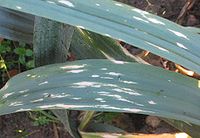
Photo from wikipedia
Since 2009, a severe decline leading to mortality has been observed affecting nearly 5 ha of a wild olive woodland of high ecological value in Seville, southern Spain. Phytophthora cryptogea… Click to show full abstract
Since 2009, a severe decline leading to mortality has been observed affecting nearly 5 ha of a wild olive woodland of high ecological value in Seville, southern Spain. Phytophthora cryptogea and P. megasperma were consistently isolated from roots and rhizosphere of trees with symptoms sampled in 2009, 2011 and 2013. The isolates were identified on the basis of colony and reproductive structure morphology as well as temperature–growth relationships, and identification was further corroborated by their ITS and β-tubulin sequences. Koch's postulates were demonstrated for both species on 1-year-old wild olives. Pathogenicity tests showed that both Phytophthora spp. are highly aggressive pathogens, although temperature–growth requirements for each species were distinct. As a consequence, the two species may be active in different seasons and their epidemiology may be differently influenced by global climate change, and they may show their active periods in different climatic scenarios. The climate change models for the Mediterranean Basin forecast a global temperature increase that favours the more thermophilic P. cryptogea. The high susceptibility to phytophthora root rot should not be disregarded in olive breeding programmes where wild olive is used as a source of resistance to verticillium wilt. This article is protected by copyright. All rights reserved.
Journal Title: Plant Pathology
Year Published: 2017
Link to full text (if available)
Share on Social Media: Sign Up to like & get
recommendations!